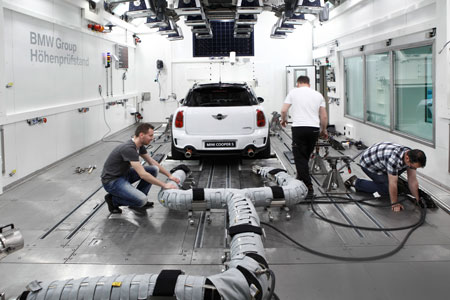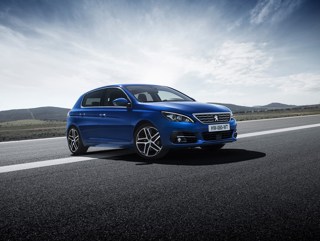The accuracy of a tool aimed at converting the CO2 value of a vehicle for tax purposes is being called into question by carmakers.
Figures suggest the programme, known as ‘CO2MPAS’, is increasing CO2 values by 10% or between 10-15g/km, on average, leaving fleet operators and company car drivers facing a potential tax increase.
It could also force some cars off choice lists, with new converted CO2 values potentially resulting in vehicles falling outside existing emission thresholds.
CO2MPAS was developed by the European Commission as a temporary measure to give cars tested under the new drive-cycle – the Worldwide harmonised Light vehicle Test Procedure (WLTP) – a comparable CO2 value to existing models tested under the former New European Drive Cycle (NEDC).
The new WLTP test was introduced alongside the Real Driving Emissions (RDE) test to give fleets and consumers emissions and fuel economy data which is much more reflective of real-world driving.
All recently launched and facelifted models have been tested under the WLTP regime since last September, while it will be used for all new cars from this September.
For its part, the UK Government has announced that it plans to start using WLTP figures for all vehicle taxation from April 2020. Until then, fleet operators and company car drivers choosing WLTP-tested vehicles will have to rely on a CO2 value determined by CO2MPAS for tax purposes, which will be published alongside the WLTP value.
Employers pay Vehicle Excise Duty (VED) and Class 1A National Insurance Contributions (NIC) on company cars. Both are based on the CO2 emission figure of a vehicle. Company car drivers are also reliant on the CO2 value of the vehicle to determine how much benefit-in-kind (BIK) tax they pay.
Martin Ward, manufacturer relationship manager at Cap HPI, told Fleet News that the data suggests there is an issue with the tool.
“Generally, the CO2 figures are higher, and the fuel consumption is worse, for cars when tested under WLTP and then converted back to NEDC,” he said. “This will potentially push cars into a higher BIK tax band.
“Furthermore, if a company has an upper limit on CO2, cars currently on a choice list may have to be removed as their new NEDC value based on WLTP testing pushes them over the limit. Yet, exactly the same car was ok before.
“Manufacturers are not happy with the CO2MPAS system.”
Fleet News understands that one manufacturer has even developed its own conversion system and is trying to get it approved, because the converted figures bear no resemblance to its own NEDC figures.
A quick look at some models that have recently been subjected to a facelift, meaning their new NEDC figure is derived from the WLTP test, shows the scale of change.
The 2016 Toyota Prius Business Edition had emissions of 70g/km, the 2018 version has increased to 78g/km.
The new Citroën C4 Cactus 1.2 Puretech 110 Flair has CO2 emissions of 104g/km, compared to the 2017 version, which had an NEDC-tested value of 100g/km. And, it’s the same story for the 2018 version of the Mazda 2 SE-L+ 1.5, which has seen an increase of 6g/km to 111g/km, compared to its NEDC-tested predecessor.
The uplift was even greater for the updated BMW X1 16d, which now has a WLTP-derived NEDC value of 118g/km, while the previous model emitted 104g/km – 12% less.
Research from Jato Dynamics also reveals a number of cars that have been re-tested under WLTP are reporting increases in NEDC correlated values, versus those obtained under the actual NEDC test regime. The uplift in emissions ranged from 6% for a Volvo XC60 to 18% for a BMW X6.
The Society of Motor Manufacturers and Traders (SMMT) has welcomed the new testing regime, but admitted there are concerns around CO2MPAS.
Mike Hawes, SMMT chief executive, told Fleet News: “The Commission has recognised a need to update the tool and is working with industry to ensure this happens promptly.”
The commission would not comment when questioned about the accuracy of CO2MPAS, but Fleet News understands it does intervene if the CO2 converted value is more than 4% higher than the manufacturer-claimed NEDC value.
If the CO2 value calculated using CO2MPAS is up to 4% higher than the value declared by the manufacturer, the type approval authority will recognise the manufacturer’s figure as the official CO2 emissions value for the vehicle.
If this is not the case, namely the CO2MPAS result is more than 4% higher than the value declared by the vehicle manufacturer, the manufacturer has the possibility to ask for a physical NEDC test to be carried out.
Differences could be down to tweaks to the NEDC test, such as the way road loads are now determined. However, Fleet News understands that the commission’s Joint Research Centre is working to ensure CO2MPAS delivers accurate results in line with the agreed procedure. And, as prescribed by EU law, a new version of the tool is expected to be available every year on September 1, until 2020.
In the meantime, the published figures for the latest models suggest an upward trend in emissions that will impact fleets in the short-term and, unless the company car tax system is overhauled come April 2020 when CO2 will be based on WLTP values, it will result in an even greater tax increase in the future.
Shaun Sadlier, head of consultancy at Arval, said awareness among fleets of WLTP is patchy and some are being slow to recognise the implications of the new test.
He warned: “While this is more than two years away, it is well within the typical lifecycle of fleet vehicles that you are buying now.
“You need to be thinking about the potential impact.”
New test proving a challenge to manufacturers
Manufacturers are facing an uphill task to get all new cars approved under the new WLTP test ahead of September, when it will apply to all new cars.
The new drive-cycle, which will replace the NEDC test, is divided into four parts with different average speeds: low, medium, high and extra high. Each part contains a variety of driving phases, stops, acceleration and braking.
Experts estimate the new test cycle takes manufacturers twice as long to complete compared to the NEDC test, plus they will have to test ‘worse’ and ‘best’ case scenario vehicles in each trim before using a formula to determine the impact of optional extras.
Furthermore, the WLTP test includes an on-the-road element – the Real Driving Emissions (RDE) test – adding another level of complexity.
An Audi spokesman told Fleet News that the risk is “cars won’t be cleared in time”.
“It won’t be whether we can make them or not, it’s whether we can approve them or not,” he said.
Other manufacturers, including Mercedes-Benz and BMW, have also acknowledged that the new testing regime is a challenge.
Martin Ward, manufacturer relationship manager at Cap HPI, said: “Manufacturers are struggling to get their cars re-homologated with WLTP; I know some manufacturers have had the dates for testing put back by a few weeks.”
The Low Carbon Vehicle Partnership (LowCVP) says the challenge is not just the new vehicles people are certifying as product updates, they also have to get every vehicle they are selling – even if it was certified a couple of years ago – re-tested to get WLTP figures.
Andy Eastlake, managing director of the LowCVP, said: “They have a huge task to meet universal WLTP data for September this year and universal RDE data by September 2019.”
In terms of test centres across the EU, the WLTP footprint is broadly similar to the NEDC one.
Eastlake said: “I do know, however, that all the UK facilities are fully utilised and booked right through to September so it is probably fair to say that there is a capacity issue.
“Given where we are now, I think it is a genuine concern over whether products can be certified in time.”























Sage & Onion - 26/03/2018 12:19
Fleets who use whole life costs as their benchmark for car allocation policies should now consider moving to a choice list using equivalent monthly contract rentals with a cap on CO2, but with the CO2 caps being uplifted by 10%-15% to what they are now, until this all settles down from 2020/21. It seems unfair that what is essentially the same car, that has still the same impact on the environment as before, is taken out of reach simply because of how numbers are calculated in the whole life costs. Yes the NIC will cost more, as will VED, but fuel won't cost any more. Or fleets should simply increase their WLC allowances and CO2 caps in their choice lists to retain the status quo for drivers. But I am already seeing an increased demand from company car drivers seeking a cash alternative instead of the Company car.